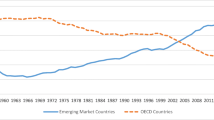Abstract
This paper revisits the time-series literature on the convergence of per capita carbon dioxide (CO2) emissions and examines the robustness of previous results. Using a sample of OECD countries for the period 1950–2002 we employ a battery of stationarity and unit root tests including those that allow for cross-sectional dependencies within the panel. We also correct for inaccuracies in previous studies that could result in a trend-stationary series being labelled as converging even if it were actually diverging from the international average. The body of evidence provided by our analysis suggests that per capita CO2 emissions have not converged among OECD countries during the period under consideration. This finding is of importance to both climate change policy makers and to those who construct climate change models.
Similar content being viewed by others
References
Aldy JE (2006a). Per capita carbon dioxide emissions: convergence or divergence?. Environ Resour Econ 33(4): 533–555
Aldy JE (2006b) Divergence in state-level per capita carbon dioxide emissions. Resources for the Future Discussion Paper 06–07
Barro RJ and Sali-i-Martin X (1991). Convergence across states and regions. Brookings Papers on Econ Activity 1: 107–182
Bodansky D (2004). International climate efforts beyond 2012: A survey of approaches. Pew Centre on Global Climate Change, Arlington, VA
Böhringer C and Welsch (2004). Contraction and convergence of carbon emissions: An intertemporal multi-region CGE analysis. J Policy Model 26(1): 26–39
Brock WA, Taylor MS (2004) The Green Solow Model, NBER Working Paper No. 10557
Carlino G and Mills L (1993). Are U.S. regional economies converging? A time series analysis. J Monetary Econ 32: 335–346
Choi I (2001). Combination unit root tests for cross sectionally correlated panels. J Int Money Finance 20: 249–272
Hadri K (2000). Testing for stationarity in heterogeneous panel data. Econ J 3: 148–161
Harris D, McCabe BPM and Leybourne SJ (2003). Some limit theory for infinite order autocovariances. Econ Theory 19: 829–864
Harris D, Leybourne SJ and McCabe BPM (2005). Panel stationarity tests for purchasing power parity with cross-sectional dependence. J Busi Econ Stat 23: 395–409
Heil MT, Wooden QT (1999) Future inequality in carbon dioxide emissions and the projected impact of abatement proposals. World Bank Policy Research Working Paper No. 2084, http://ssrn.com/abstract=620490
Heil MT and Selden TM (1999). Panel stationarity with structural breaks: carbon emissions and GDP. Appl Econ Lett 6: 223–225
Im KS, Pesaran MH and Shin Y (2003). Testing for unit roots in heterogeneous panels. J Econ 115: 53–74
Intergovernmental Panel on Climate Change (2001) Climate change 2001, synthesis report, IPCC report. http://www.ipcc.ch/pub/un/syreng/spm.pdf
Kwiatkowski D, Phillips PCB, Schmidt P and Shin Y (1992). Testing the null hypothesis of stationarity against the alternative of a unit root: how sure are we that economic time series have a unit root?. J Econ 54: 159–178
Lanne M and Liski M (2004). Trend and breaks in per-capita carbon dioxide emissions, 1870–2028. Energy J 25(4): 41–65
List JA (1999). Have air pollutant emissions converged amongst U.S. regions? Evidence from unit-root tests. South Econ J 66: 144–155
Mankiw NG, Romer D and Weil DN (1992). A contribution to the empirics of economic growth. Q J Econ 107: 407–437
Marland G, Boden TA, Andres RJ (2003) Global, regional, and national fossil fuel CO2 emissions. Trends: a compendium of data on global change. Carbon Dioxide Informational Analysis Centre (CDIAC) Oak Ridge National Laboratory, US Department of Energy, Oak Ridge, Tennessee, USA
Meyer A (2000). Contraction and convergence: the global solution to climate change. Schumacher briefings. Green Books, Bristol, UK
Moon HR and Perron B (2004). Testing for a unit root in panels with dynamic factors. J Econ 122: 81–126
Ng S and Perron P (2001). Lag length selection and the construction of unit root tests with good size and power. Econometrica 69: 1519–1554
Nguyen-Van P (2005). Distribution dynamics of CO2 lag length selection and the construction of unit root tests with good size and power. Econometrica 69: 1519–1554
Nieswiadomy ML and Strazicich MC (2004). Are political freedoms converging?. Econ Inquiry 42(2): 323–340
O’Connell PGJ (1998). The overvaluation of purchasing power parity. J Int Econ 44: 1–19
Pearce F (2003). Saving the world, plan B. New Scientist 180(2425): 6–7
Perron P (1989). The great crash, the oil price shock and the unit root hypothesis. Econometrica 57(6): 1361–1401
Pesaran MH (2004) General diagnostic tests for cross-section dependence in panels. IZA Discussion Paper Series, DP n. 1240
Phillips PCB and Perron P (1988). Testing for unit roots in time series. Biometrika 75: 335–346
Phillips PCB and Sul D (2003). Dynamic panel estimation and homogeneity testing under cross sectional depenedence. Econ J 6: 217–259
Quah D (1996). Empirics for economic growth and convergence. Eur Econ Rev 40: 1353–1375
Quah D (1997). Empirics for growth and distribution: stratification, polarization and convergence clubs. J Econ Growth 2: 27–59
Rappoport P and Reichlin L (1989). Segmented trends and non-stationary time series. Econ J 99(395): 168–77
Stegman A, McKibbin WJ (2005) Convergence and per capita emission. Brookings Discussion Papers in International Economics. no. 167
Strazicich MC and List JA (2003). Are CO2 emission levels converging among industrial countries?. Environ Resour Econ 24: 263–271
Author information
Authors and Affiliations
Corresponding author
Rights and permissions
About this article
Cite this article
Barassi, M.R., Cole, M.A. & Elliott, R.J.R. Stochastic Divergence or Convergence of Per Capita Carbon Dioxide Emissions: Re-examining the Evidence. Environ Resource Econ 40, 121–137 (2008). https://doi.org/10.1007/s10640-007-9144-1
Received:
Accepted:
Published:
Issue Date:
DOI: https://doi.org/10.1007/s10640-007-9144-1




